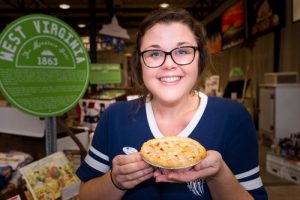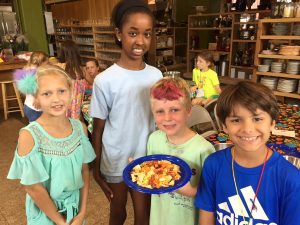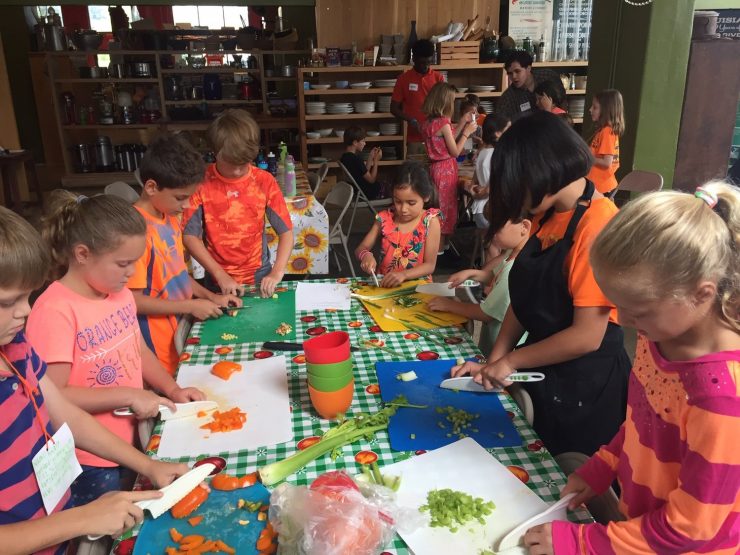May 14, 2020
Where to start when teaching your kids to cook at home.
Wishing your kids would magically cook a real dinner or make breakfast, not just pour cereal into a bowl? If so, you’re in luck! Our local Southern Food & Beverage Museum (“SoFab”) is a great resource for teaching kids of all ages how to cook during these stay-at-home days.
[button color=”green” size=”normal” alignment=”center” rel=”follow” openin=”newwindow” url=”http://eepurl.com/gnPI_b”]Sign up to receive our Nola Family newsletter![/button]
SoFab recently brought their children’s cooking lessons online. While SoFab previously offered a year-round schedule of on-site cooking classes, cooking camps, and party bookings (like cupcake decorating), now you and your kids can upload entertaining, instructional videos to watch and “cook along” from your home kitchen.

Jennie Merrill, Director of Education at SoFab, posts a new, free, kids’ food activity each weekday at 1:30 pm. “I started SoFAB Kids, a new YouTube channel, where I film cooking videos in my house. Each video features a link that takes you to our website, where you’ll find the actual recipe, a separate fun activity, and “Exit Ticket” quiz. This way parents and kids can slot a class to fit their timeframe – whether shorter or longer.”
First tries- great recipes to begin with!
The SoFab channel includes dinner lessons (pizza, pasta, tacos, burgers), breakfasts (blueberry pancakes), and baking muffins and cookies, among others. There are additional online child-oriented recipe resources like Bon Appetit and Food Network, among others.
Key tip from Jennie Merrill: “I highly suggest starting with breakfast foods or desserts. Kids love baking, no matter the age. These classes are what’s requested most often.”
Breaking down instruction by age-appropriate skill level is a good way to start. Of course, you know your kids’ abilities better than we do. Some kids take to cooking like fish to water and others find it more difficult. Modify recipes for your children, knowing their individual patience and motor skills levels.
Ages 3-5 and up
Start younger kids with basics, like stirring and mixing pancake, cookie, and cake batters with a wooden or plastic spoon. Plastic bowls are ideal for this age. Have the kids stand on a steady footstool with rubber feet so they can work at a kitchen table or low counter top. (Footstools also are useful for kids up to age ten, depending upon their height.)
This age can develop knife skills by cutting up soft things, like strawberries, using a plastic knife. For pie crusts and ice cream decorations, they can crush up Graham crackers or Oreos inside a heavy Ziplock bag using the bottom of small saucepan.
Ages 5-8 and up
 Kids this age can measure ingredients reliably using measuring cups and spoons; this is a good way to teach basic math. Also, they can use an ice scoop to make uniform cookies and snacks on a baking sheet. Kneading soft ingredients – shaping burgers and meatballs – is fine now, as they understand not to lick their fingers automatically!
Kids this age can measure ingredients reliably using measuring cups and spoons; this is a good way to teach basic math. Also, they can use an ice scoop to make uniform cookies and snacks on a baking sheet. Kneading soft ingredients – shaping burgers and meatballs – is fine now, as they understand not to lick their fingers automatically!
Start using a serrated plastic knife to cut things with a skin or a rind, but not hard ingredients yet (like potatoes or carrots). Sweet red and yellow bell peppers and cucumbers are perfect for slicing and then snacking. And make dips for the veggies!
You can also introduce small hand tools — with a watchful eye — including a cheese grater, peeler, handheld juicer, or zester. Use a hand mixer with your hand on top of theirs until they master control. Also, with oversight, begin sautéing in a skillet over medium heat.
Ages 8-11 and up
This age group is so curious and ready to show you that they can do anything, but they still need guidance and supervision. Teach differences between knife cuts: sticks, cubing, dicing, mincing – though always with a close eye on how they hold their knives. (If you’re teaching several kids at once, have them take turns with the knife to avoid accidents.)
These kids also grasp the importance of accuracy – in measurements, cooking temperatures (oven and stovetop), and cooking times. Ask them to read the recipes and then tell you what the next steps will be, and together prepare ingredients sequentially for each step. Continue stovetop sautéing, and introduce more appliances (mixers, food processors) – always stressing safety.
Preteens-Teens
At this age, kids should have basic kitchen skills mastered and the fine motor skills needed for seamless recipe execution. Always be in the kitchen with your kids until you are certain they can safely use all needed tools – knifes included – and equipment, from burners to ovens and food processors.
Ask these kids to read recipes twice and discuss the steps over with you, and then have them double-check the ingredient list and prepare all ingredients in bowls before beginning the actual cooking. In this way, their process will not be rushed, and they’ll learn to cook like pros!
Advice for all ages, parents included: Safety! Remind your cooking students to wash their hands well and wipe down all cooking surfaces and counters before beginning. And to always wash hands after handling raw proteins, like meat, eggs, and fish. Keep focused when using knifes and fire, and use proper oven mitts when lifting pots, pans, and baking sheets.
And have fun!
![]() Trevor Wisdom is the Managing Editor of nola family magazine and her sister publication, nola boomers magazine.
Trevor Wisdom is the Managing Editor of nola family magazine and her sister publication, nola boomers magazine.


